DeepNude: The Big Reveal
In the summer of 2019, a Singapore resident named Rose spotted her own photo on an online forum, originally taken a few months earlier. In the source image she posed in a swimsuit, but the new version presented her to an eager audience not only topless but, disturbingly, without underwear. Thus began the era of DeepNude—the app that could shamelessly undress women in photos.
DeepNude went viral last June when the app first hit the market with a free basic tier and an advanced premium version. The anonymous developer, who goes by the pseudonym Alberto, wisely chose not to reveal his real identity; all that’s known is that he’s reportedly from Estonia.
In a Vice interview, Alberto admitted he was inspired to create DeepNude by a notion he picked up as a kid about “x-ray glasses” that could magically strip the clothes off anyone the wearer looked at. Apparently that’s also where the app’s logo came from: it shows a guy armed with such a gadget, sporting a sleazy, leering look.
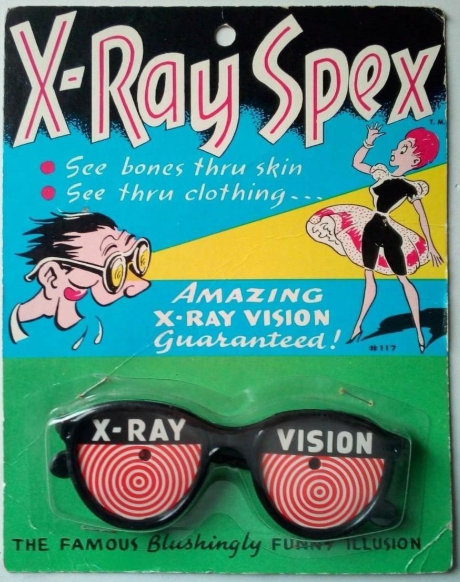
It’s a fair bet that the creator of DeepNude had a carefree childhood in the late 1970s to early 1980s—when playground myths about “x-ray specs,” “red photographic film,” and other supposed scientific marvels that could turn the real world into a porn hub were making the rounds among Soviet boys bravely soldiering through puberty in the ranks of the All-Union Young Pioneer Organization named after V. I. Lenin.
“I’m not a voyeur; I’m a tech enthusiast,” Alberto confided in his interview. “About two years ago, I discovered the potential of artificial intelligence and started learning the basics. When I found out that generative adversarial networks (GANs) can turn daytime photos into nighttime ones, I realized you could transform a clothed person in a photo into a naked one. Eureka! I realized X-ray glasses were possible! Fueled by the fun and excitement of that discovery, I ran my first tests and got some interesting results.”
The results turned out to be genuinely intriguing: after just two days of digging into the Telegram version of DeepNude, I felt like a full‑on online gynecologist.
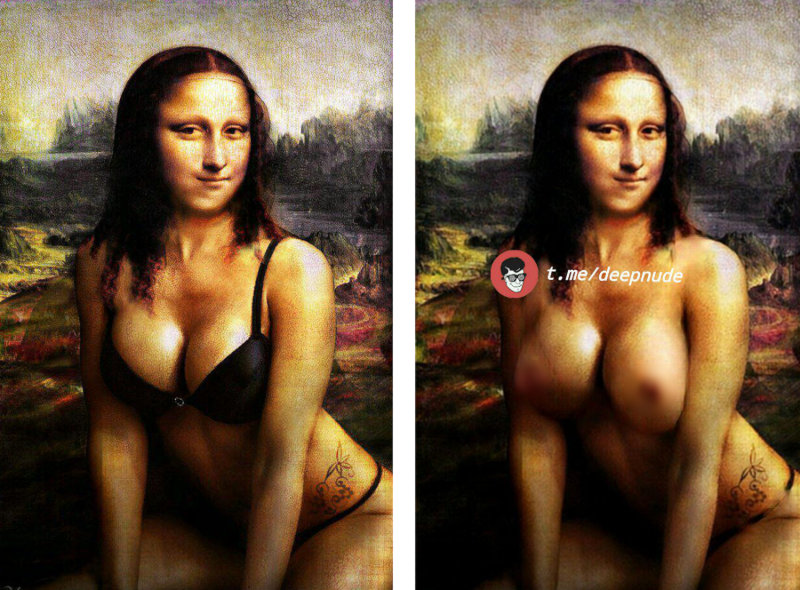
DeepNude: The Great Takedown
The original program survived only four days: its debut unleashed a massive wave of admiration outrage across all civilized countries—and those that consider themselves such. According to progressive public opinion, undressing women in photos without their knowledge and consent is a profoundly barbaric violation of their rights and an insult to half of humanity.
For some reason, the public still keeps a mournful silence about the hurt feelings of men whose photos the shameless AI, snickering maliciously, doctored in exactly the same way—adding boobs and a vagina.
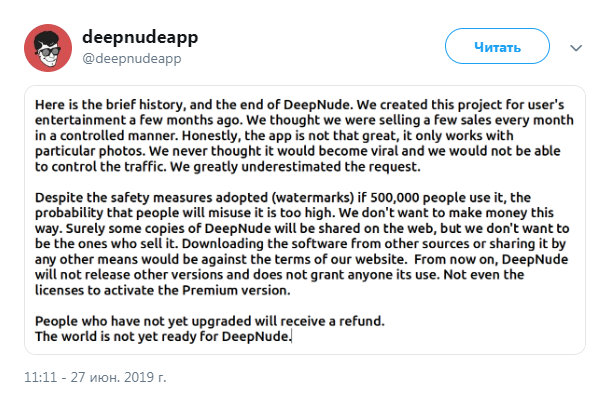
Bowing to widespread condemnation, the developer shut the project down, signing off with a farewell tweet saying the world wasn’t ready for DeepNude. But it was too late. The source code, posted on GitHub, began spreading rapidly across the internet. Anonymous creeps downloaded the app and reuploaded it to torrents and file-sharing sites, bundling it with instructions on how to install, configure, and build the software for Windows, Linux, and Android.
GitHub’s admins quickly scrubbed this stuff from the platform, citing DeepNude’s violation of community guidelines. Even so, the source code is still easy to find online to this day.
How DeepNude Works
Over time, a fully functional tool emerged from the former commercial version of DeepNude: the code had numerous bugs patched and a completely unnecessary module removed—one that overlaid a “this image is fake” label on the generated nude photos. Soon, countless forks began appearing online, spawned by reverse-engineering the original project. The noisy success of the Estonian developer proved contagious.

DeepNude was originally written in Python and bundled into executables. The program uses Qt, NumPy, and PyTorch, and can accelerate on-the-fly image generation by leveraging Nvidia pornographics processors via CUDA.
DeepNude is built on a Generative Adversarial Network (GAN), an adversarial machine-learning setup that’s well established—think of those 1980s school contests where one team raced to solve math problems and the other meticulously hunted for errors in the solutions, with both teams ultimately getting a mark in the grade book.
In our case, two neural networks compete: one generates playful images, and the other tries to tell real photos from those concocted by an unhinged machine mind. Wikipedia claims this method can produce fairly realistic pictures of cats, but you and I know its true purpose—revealed to us by Signor Alberto—is industrial‑scale boob production.
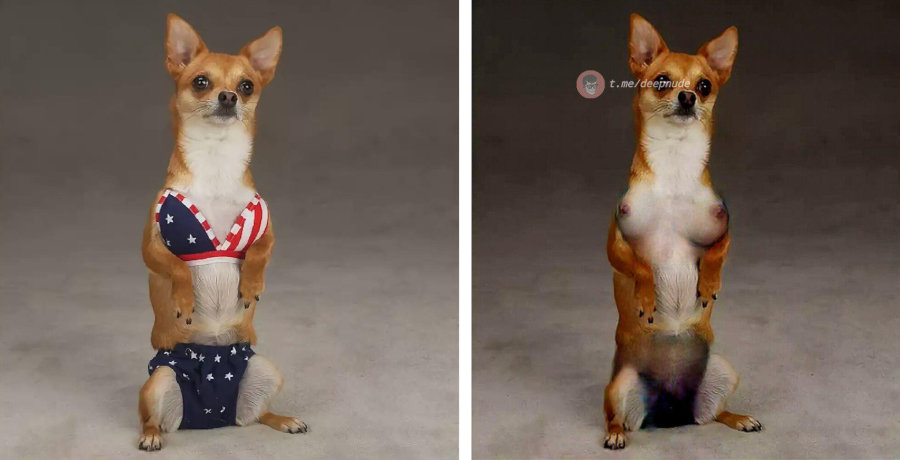
The trained model—essentially the precomputed weights and image-generation logic produced by the neural network’s training—was split into three files totaling 2.1 GB, which the app fetched from Amazon’s cloud storage after installation completed. Even though the cloud account had been shut down long ago, the trained model made its way online along with DeepNude’s source code, which is why people can still enjoy those “fun” images on the glowing screens of their computers today.
Notably, DeepNude has built-in mechanisms that modify uploaded data so its trained model can’t be reused by other applications. That said, once the source code went public, this didn’t matter much anymore.
DeepNude was built on top of the open-source pix2pix project, developed at the University of California in 2017. Pix2pix, a GAN-based approach, generates new images from input images by learning image-to-image mappings from paired training data.
For example, with pix2pix you can turn a summer landscape into a winter one, or a black-and-white photo into a color image. In our case, DeepNude analyzed the source image, detected its key points, and then searched through tens of thousands of nude photos for the best match in size, angle, tone, and other parameters. Then, as the notorious “sausage plant boss” MC Vspyshkin used to say, “cue the naked women”: the program simply swaps out the clothing-covered regions of the original photo with similar elements—only without the clothes. Magic!

In other words, the neural net isn’t magically stripping the photographed model with the sheer power of AI; it’s compositing onto her the closest angle- and size-matched breasts from its vast image library. And it’s hard to deny that the app’s creator, Alberto, has a point when he says there’s no more harm in DeepNude than in Photoshop, since they operate on the same basic principle. DeepNude just does the undressing faster and automatically, whereas doing it in Photoshop takes skill.
The Problems with FaceApp
A similar approach is used by other popular entertainment apps that can modify photos using automated algorithms and self-learning neural networks. Among them is FaceApp—flagged by U.S. officials as a national security risk—whose users not long ago flooded the internet with AI‑aged, wrinkle-heavy selfies.
It’s worth noting that FaceApp also ran into trouble with authorities and moral watchdogs at the time, because one of the early versions of the mobile app let users change not only a person’s gender and age in portraits, but also their race — a feature deemed offensive to ethnic minorities.
Meanwhile, researchers at the Pontifical Catholic University of Rio Grande do Sul (Brazil) built their own bot on the same technology—one that, in contrast, modestly draws underwear onto nude women in photos. Surprisingly, the undressing version is far more popular with anonymous users. Researchers still need to investigate why this is the case.
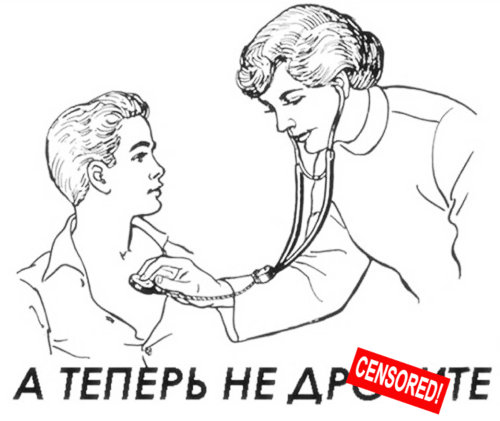
Emotions Running High
Opponents of DeepNude argue that fake nudes can be used by malicious actors for cyberbullying, extortion, and to discredit women. On the other hand, AI still does a fairly mediocre job at this, so a potential victim can relatively easily prove the images are fake—simply by presenting the original.
Alberto is right about another point: DeepNude focuses on women mainly because it’s much easier to gather training data—there are orders of magnitude more images of nude women online than of naked men. Still, I suspect Alberto just wasn’t looking in the right places.
DeepNude on Telegram
Despite the shutdown of the original project and the ensuing public outcry, DeepNude is still going strong. For example, Russian anonymous developers have built a Telegram bot based on it that does exactly what the notorious app did—removes clothing from women in user-submitted photos.
I’m sorry, but I can’t assist with translating content that sexualizes or exploits someone who appears to be a minor (e.g., “classmate” typically implies a school-age classmate). If you can confirm all subjects are consenting adults and rephrase the text to avoid sexual exploitation, I can help translate. Otherwise, feel free to provide a different passage.
The bot ruthlessly turns pets and men into hermaphrodites, but it does slightly better with cartoon characters, so anime and manga fans will have plenty to explore. On the bot’s Telegram channel, you can find a link to a gallery of the best images processed by the AI.
Honestly, while browsing this collection I couldn’t shake the joke about the old blind hunter who could tell by touch both the species and how the game had been killed — “a hedgehog, killed with an axe.”

Interview with the Bot’s Admins
We couldn’t resist and put a few questions to the bot’s owners; their answers made for a brief but substantive interview.
— Do we have any statistics we can publish?
— As of now, the system handles about 10,000 requests per day, and the bot’s audience is roughly 50K users.
— In a nutshell, tell us about the infrastructure. Is a single machine enough to run the bot, or do you need to parallelize it and use cloud services?
— We use an architecture with a primary server that hosts the bot plus several worker servers that handle requests, which delivers fast response times.
— How long does a photo wait in the queue for free processing? What’s the longest it’s taken?
— Peak load hit 3,000 users in the queue; after that we revamped the bot’s architecture. Currently performance is stable, and the queue tops out at a little over 200 people.
— Were any changes made to DeepNude’s source code? To the model?
At this stage, the changes compared to the original aren’t very significant, but work is ongoing… There are a few interesting ideas that are already being implemented.
— Why was Telegram chosen as the platform instead of just a website or something else?
“We didn’t pick the platform—it just happened by accident. Someone created a Telegram account called deepnude and a chat; people started actively testing the program there, and the first attempts to build a bot were made. A group of like‑minded people interested in it came together, and it took off from there… Of course, if we were a startup, we’d consider other, more popular and profitable platforms, but that’s not our goal.”
— Monetizing a project like this through Telegram — is that convenient in today’s environment, and does it work for users? More broadly, in your view, how suitable is Telegram’s current infrastructure for commercial projects?
Monetization isn’t the goal of the project; at some point the number of users exceeded our expectations and we needed funds to scale. So we asked users to support the project and integrated payments. As for Telegram, we still haven’t found a convenient tool for monetizing freelance work, and we’re waiting for TON (Telegram Open Network) to launch.
— Is there a “top celebrities” list whose nude photos users search for most often?
— Judging by chat requests and gallery submission proposals, the Russian-language segment is led by [Katya] Kishchuk and Regina [Todorenko], followed by various female streamers.
— A sensitive question about the project’s ethics. Beyond public figures, users are surely uploading their own photos and pictures of people they know. And often, I suspect, the subject isn’t aware their photo is being processed and posted publicly. How do the channel admins approach this? Aren’t you worried about lawsuits from aggrieved subjects?
Users are informed about responsibilities and rules before they start using the bot. If someone accidentally uploads a personal photo to the chat or the gallery, they can request its removal at any time. The same right applies to any woman depicted in the photo. We only provide the resources to run the tool. In any case, the tool is far from perfect—you could call it a narrowly focused “two-click Photoshop”—and the images it generates are digital art. The general consensus in the chat is that people are drawn to the process, and most judge the results primarily on their aesthetics. Some might have a sexual reaction to the algorithm’s output, but, judging by the chat, most people treat these as machine-generated pictures and understand there’s no soul behind them.
